The best Rome monuments to include in your Rome itinerary. A selected list of Rome monuments including grand and understated, famous and lesser know landmarks in Rome.
Rome has many beautiful monuments: some are grand and famous, others are small and understated, but all have some story to tell that makes them worth a visit.
Out of the many I can think of, these are those I recommend to see during your first trip to Rome, with tips for visiting and interesting tidbits about each.
This is my list of the best Rome monuments.
Good to know: many of these Rome monuments are free to visit! You can find my list of free Rome attractions here.
Please note: this post contains affiliate links and, should you make a purchase through them, we might make a small commission.
Rome monuments list + tips for visiting
The Roman Colosseum
The Colosseum is THE main monument in Rome, the one everyone visits and the one most evocative of the city.
Built during the last decades of the I century AD and inaugurated by Emperor Titus in 80 AD, it is the biggest Roman amphitheater anywhere in the world and it has worked for centuries as a theater and stadium, hosting gladiator games, hunts and theatrical representations.
The Colosseum is open to the public: advance booking is necessary. You can find fun facts about the colosseum here and our tips for visiting here.
The best Colosseum tickets can be booked at the following addresses:
- Colosseum Ticket Office
- Colosseum and Roman forum priority entrance
- Colosseum, Roman Forum and Palatine Hill package
- Colosseum and Roman Forum tour for families with kids
The Roman Forum
The Roman forum is another work famous Rome landmark.
Part of the same archaeological park as the Colosseum, it is a stunning site where you can see ruins from Republican and Imperial Roman times and from where you access the Palatine, the hill were Rome was founded and where Augustus had his palace.
You can read all about visiting the Roman Forum here.
The Vittoriano/Altare della Patria
Il Vittoriano is a large distinctive monument located in Piazza Venezia, a stone throw from the Colosseum, in the heart of Rome city center.
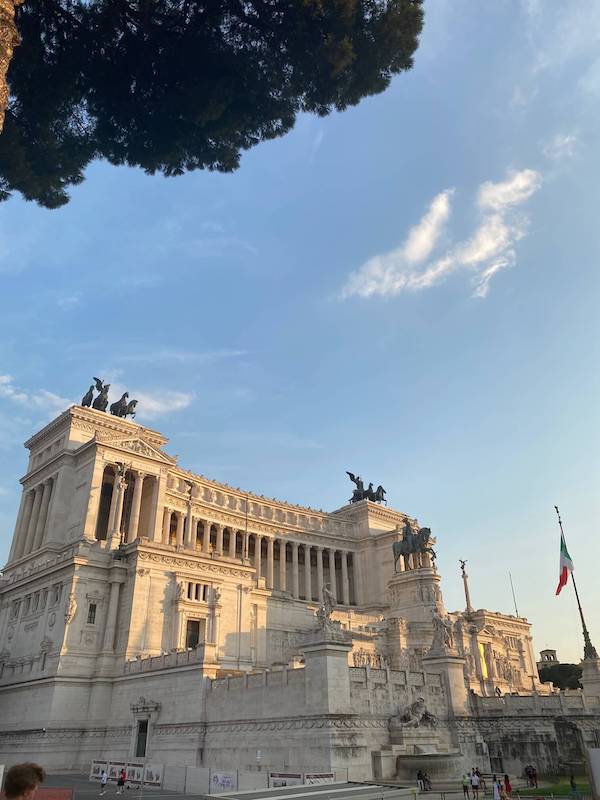
Built in the XIX century (1885) in neoclassical style, it is huge and commands attention with its large size, blinding white colors and the statues of winged Nike on the top: a vision, against the Rome blue sky!
The monument was built to celebrate Vittorio Emanuele King of Italy (hence the name ‘Vittoriano’) and it is also known as Altare della Patria, homeland altar.
Today it has a monument to the unknown soldier, constantly guarded by the Italian military, and is hosts the museums of the Risorgimento and a beautiful art space, which usually hosts high caliber art exhibitions.
The Vittoriano has a series of terraces, some of which can be accessed for free: you get some of the best views over Rome from here!
Fun fact: because of its peculiar shape, Romans often call this, monument ‘the typewriter’ while English speakers often prefer to identify it as a ‘wedding cake’. Love it or hate it, it is one of the most important Rome monuments and a Rome must-see.
The Pantheon
The Pantheon is one of the most beautiful, peculiar and interesting monuments in Rome and a place that never fails to impress its visitors, whether it is their first time in Rome or they are local.
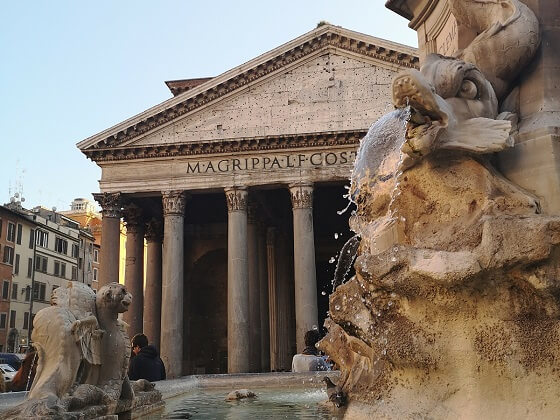
Originally built in the II century AD as a temple to all deities and now a Catholic church, it is one of the best-preserved ancient Roman monuments in the city and one full of surprises, myths and stories, that have to do with the peculiar hole in its roof, special proportions and a natural light effects happing here during specific astronomical events.
You can read how to visit and interesting Pantheon facts here.
Access to the Pantheon is free however, guided tours are also available. Check out this one, also including nearby Santa Maria Sopra Minerva (church) also worth seeing.
Trevi Fountain
The Trevi fountain is one of the most beautiful fountains in Rome and the most famous.
Built in the XVIII century following a design of architect Nicola Salvi, it is located in a small and otherwise understated small square in Rome city center (Piazza di Trevi) and it an imposing, impressive sight.
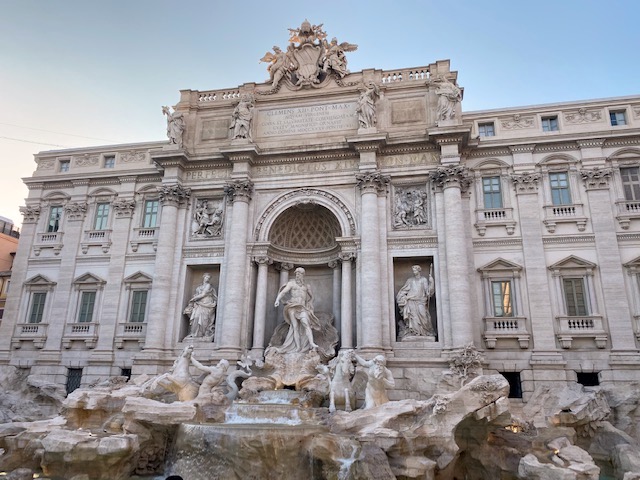
Sculpted in white travertine, a local type of stone common in Rome architecture, it has a series of impressive statues and sculptures representing Oceanus and the abundance that comes from the presence of fresh water, flowing here from the ancient Aqueduct Virgo.
The Trevi fountain is on an open square and is, therefore, free to visit: you literally stumble upon it as you stroll around Rome!
Please note: while Fellini made the fountain movie-famous filming Anita Ekberg wading into it in a ballgown, entering the fountain is strictly prohibited.
You can read all about the Trevi Fountain here.
Spanish Steps / Piazza di Spagna / Trinita’ dei Monti
The Spanish Steps (Scalinata di Trinita’ dei Monti in Piazza di Spagna) is another famous monument in Rome and one that raised to iconic status.
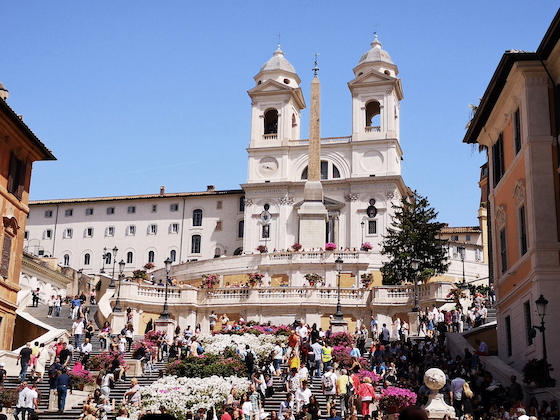
Located in the city center, is it a monumental staircase of 136 steps that connects Piazza di Spagna with Trinita’ dei Monti, the double towered church on the hill above it.
The monumental staircase was built in 1723-1725 and is stunning and unique especially in spring, when it usually gets decorated with blooming flowers.
Like the Trevi Fountain, this is an outdoor Rome landmark and it is, therefore, free to visit. Please note that sitting on the steps has been banned to help preserve this important structure.
Piazza del Campidoglio and Marcus Aurelius statue
Piazza del Campidoglio is one of Rome’s most famous and beautiful piazza and an important city landmark.
The piazza lies at the top of the Capitoline Hill, one of the seven hills of Rome and acquires the appearance we see today thanks to the genius of Michelangelo, who designed it in the early 1500s.
The Piazza is home to a monumental staircase, the only existing bronze equestrian statue from Roman times, the stunning Capitoline Museims and also offers breathtaking views over the Roman forum.
You can read about this important Rome landmark in my guide to the Capitoline Hill.
Castel Sant’Angelo
Castel Sant’Angelo is Rome’s castle but it wasn’t born as one.
The structure was originally built by Emperor Hadrian in the II century AD, who wanted it as its final resting place and its original name, Hadrian’s Mausoleum, still bears witness to that.
Over the course of the centuries, the castle changed use and, partially, structure and became a fortified refuge for the Pope, who would escape here from nearby Vatican City whenever in danger from invaders.
Castel Sant’Angelo is open to the public.
Tickets can be booked here.
St Peter Basilica and St Peter Square
Arguably, St Peter’s Square and basilica should not be on this list since they belong in Vatican City, an independent State. However, since the Vatican is physically inside Rome, I reckon the inclusion is legitimate!

St Peter Square and Basilica and an impressive architectural complex made of a large monumental square with semi-circular colonnaded and a vast cathedral, with an impressive facade and world-famous dome.
St Peter’s church was built above the tomb of the Apostle Peter and acquired the impressive appearance it has today by the hands of masters of the caliber of Michelangelo, Raffaello and Bernini.
Worth seeing here are the square itself, the basilica (inside and out), the Vatican museums and the Sistine Chapel (access is from a different side of the building) and the Vatican Gardens.
Find here practical info on the Vatican to plan a stress-free visit.
Caracalla’s Baths
Caracalla’s bath are a large archaeological complex in Rome, open to the public for visits and, in summer, also as a venue for opera concerts (a wonderful place in Rome after dark!).
The baths are wonderful: many of the tall walls of the baths are still standing, giving a clear idea of the size this complex must have had at the time, and pine trees and wisteria grow around these ancient ruins, giving the whole place a romantic atmosphere.
The baths have a ticketed entrance – you can find our guide to Caracalla’s Baths here.
Fun fact: you can see the baths in the Woodie Allen movie to Rome with love. You can find more movies set in Rome here.
The fountain of the Four Rivers and Piazza Navona
Piazza Navona is a monumental piazza in Rome city center.

Originally a Roman stadium, built by emperor Domitian, the square acquired the stunning appearance it has today during the Baroque Period, when several sculptures and monuments were commissioned to embellish it.
The most important and famous are the church of Santa Agnese is Agone, built by Borromini, the Fountains of the four rivers (Fontana dei Quattro Fiumi) by Bernini and the two additional fountains at the two edges of the square, Fontana del Moro and Fontana del Tritone.
Rome’s pyramid
The most peculiar and unexpected monument in Rome is Rome’s pyramid, an ancient Egyptian style pyramid dating back to ancient Rome, the I century Ad to be precise.
The pyramid is the grave of a wealthy roman G Cestius and is worth seeing for its uniqueness. You can learn all about Rome’s pyramid here.
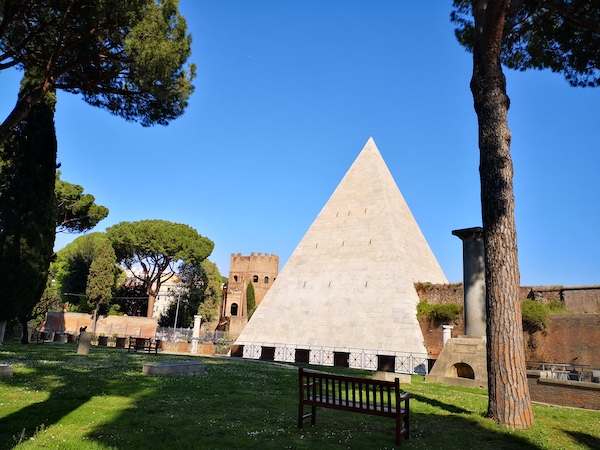
Circo Massimo
Circo Massimo (Circus Maximus) is an ancient Roman chariot stadium located in the center of Rome, near the Colosseum.
The stadium offers little to see per se however, from it you get wonderful views of the Palatine hill and the palace of the emperors, some of the most impressive vestiges of the Roman empire.
Access to the circus is free, virtual reality visit available on selected dates for a fee. Find all the info about Circo Massimo/Circus Maximus here.
The Mausoleum of Augustus: new for 2021!
In March 2021 a new Rome monument joined the list of historical landmarks open to the public: it is the Mausoleum of Agustus, the tomb of Rome’s first emperor, open to visitors again after 14 years and extensive restoration work.
Learn how to plan your visit and why the Mausoleum of Augustus is significant here.
Berninis’ elephant
In a small square beside the Pantheon, Piazza della Minerva, lies a small monument by Gian Lorenzo Bernini, representing a small elephant carrying an obelisk.
The small statue is a fun and maybe not as important and known as other Rome monuments on this list.
However, I want to include it because it has a really interesting and fun story (which you can read here) and also as a symbol of all the small, lesser-known monuments and statues in the city.
The elephant is one of them, but others come to mind such as the Turtles’ fountain in Piazza Mattei, the Frogs’ fountain in Piazza Mincio, all of Rome’s talking statues, Giordano Bruno’s statues in Campo de’ Fiori, Michelangelo’s Moses in San Pietro in Vincoli just to name a few!
I hope you enjoyed this overview of Rome monuments and it helped you plan your Rome itinerary at best. Happy travel planning!

